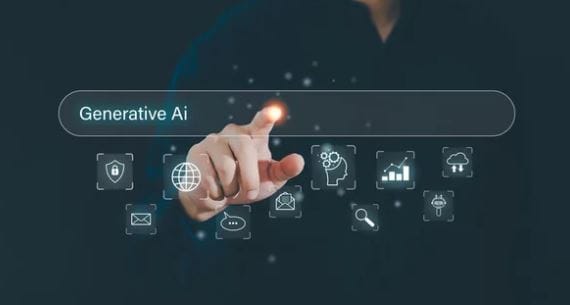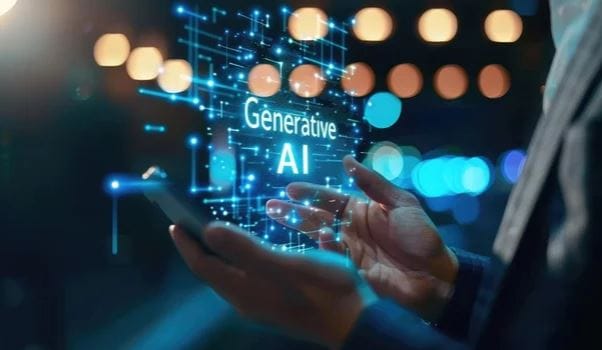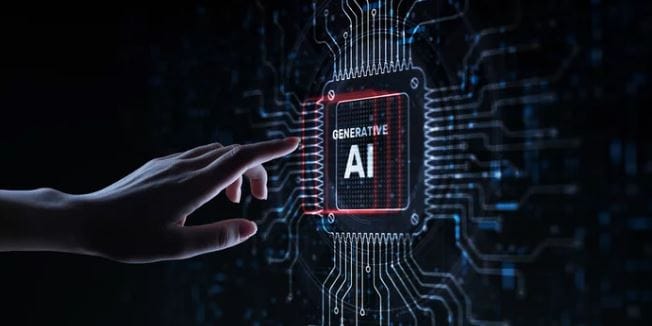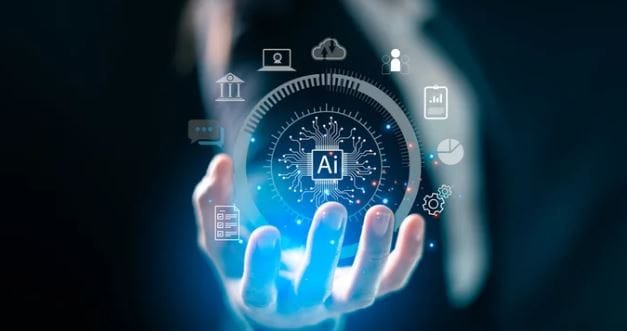The digital territory experiences a leading revolution from the artificial intelligence subset known as generative AI. Generative AI uses well-developed machine learning models especially deep neural networks to develop new content types including text text, images, videos, audio and software code. The worldwide industrial interest has grown because this technology automates creative work and boosts productivity in various fields including software development and healthcare as well as finance and entertainment.

👉What is Generative AI?
Generative AI evaluates extensive data sets through sophisticated algorithms that can recognize these datasets’ fundamental patterns. Artificial intelligence uses identified patterns to create new content that human judges cannot detect as artificial. AI technology differs from traditional systems by establishing new outcomes through received inputs instead of working primarily to analyze and classify information. AI capabilities enabled developers to create substantial technology tools including ChatGPT for text generation and DALL-E for image generation and AI-powered music composition systems.
👉Key Technologies Behind Generative AI :-
⏩Content Creation :-
Generative artificial intelligence primarily depends on deep learning models based on human brain techniques for processing and creating information. Transformer-based architectures among other models have the ability to handle intricate data collections when producing advanced outputs.
⏩Personalized Learning Materials :-
Transformer Models represent the current generation of leading generative AI solutions through their models GPT-4 and GPT-5. The massive number of parameters in these systems enables them to understand contexts and produce valuable responses thus making them essential for article and report writing tasks.
⏩Image & Video Generation :-
AI systems gain abilities from Reinforcement Learning together with Self-Supervised Learning through both the process of experimentation-based development and unsupervised data training. The capability of generative AI to become more efficient with new tasks remains possible due to this functionality.

👉Applications of Generative AI :-
Generative AI serves different sectors through its numerous applications.
1. Content Creation :-
⏩Text Generation :- AI text generators including ChatGPT transform content creation by producing articles as well as scripts and poetry to benefit companies in both publishing and marketing fields.
⏩Image Generation :- DALL-E and Mid journey together with Image & Video Generation technology create beautiful artwork and videos that serve advertising and entertainment and digital marketing purposes.
⏩Music Composition :- AI-based music composition generates innovative songs from different musical styles to foster creativity within the music production sector.
2. Healthcare Innovations :-
⏩Medical Reports :- Medicine reports become more efficient through AI diagnosis support which enables doctors to produce better and more precise medical assessments.
⏩AI Chatbots :- It present immediate health guidance to patients thus improving their experience and medical support.
⏩Pharmaceutical Research :- Artificial intelligence uses drug formulations to accelerate pharmaceutical research along with its development processes.
3. Business Automation and Customer Service :-
⏩AI Chatbots :- It enables the processing of customer questions which supports support team workforce reduction while simultaneously enhancing customer satisfaction level.
⏩Personalized Recommendation :- AI creates individualized product recommendations that build superior customer satisfaction for e-commerce retailers and retail outlets.
⏩Marketing Campaigns :- AI technology produces marketing videos which enable businesses to create enhanced and successful advertising materials.
4. Education :-
⏩Interactive Learning Tools :- The technology enables AI systems to develop interactive teaching materials including animated holographic items that improve student education.
⏩Automated Grading :- The grading process becomes automated through AI which allows teachers to direct their attention to classroom instruction.
5. Finance and Banking :-
⏩Automated Reporting :- AI systems produce financial reports which cuts down manual work and enhances accuracy levels.
⏩Risk Analysis :- AI platforms use extensive financial datasets through risk analysis to detect market trends and locate potential business risks.
👉Impact on Industries :-
The usage of generative AI technology drives industrial revolution by streamlining work processes and rising creative output and operational performance.
1. Manufacturing :-
⏩Design & Prototyping :- AI technology produces product designs which reduces both product development expenses and duration.
⏩Quality Control :- It’s function improve through AI systems that analyze production data both to forecast and stop product defects.
2. Retail :-
⏩Personalized Marketing :- Artificial intelligence develops custom-made marketing advertisements and purchase suggestions which lead to better customer interactions.
⏩Inventory Management :- The combination of AI technology enables organizations to anticipate product requirements while maximizing inventory storage that leads to diminished cost and enhanced supply chain operations.
3. Entertainment :-
⏩Content Creation :- The entertainment industry faces transformation because AI now produces music and scripts and creates videos which shape how content is made.
⏩Virtual Events :- Artificial Intelligence uses virtual environments to develop interactive spaces which improve the experience of event audiences.
4. Agriculture :-
⏩Crop Yield Prediction :- AI analyzes weather patterns together with soil conditions to project agricultural harvest amounts thus enabling farmers to maximize their planting and harvesting operations.
⏩Livestock Management :- Artificial Intelligence system enables farmers to observe animal health together with behavioral patterns to enhance both agricultural productivity and animal care standards.

👉Challenges and Concerns :-
Generative AI represents a transformative tool that creates various challenges because of its ethical issues.
⏩Intellectual Property Issues :- Generative AI models used for training deal with copyrighted material which creates problems about ownership and originality questions.
⏩Misuse & Deception :- AI-generated content endures misuse in addition to deception because it enables deep fake creation and fake information distribution leading to ethical and societal problems.
⏩Job Displacement :- When creative tasks become automated this leads to potential job loss in industrial environments that place value on human creative abilities.
⏩Cybersecurity Risks :- AI systems integrated within business operations create new cybersecurity risks which need proper attention because they connect operations to new security vulnerabilities.
👉Impact on Education :-
Generative AI creates significant changes in educational systems while also introducing both positive aspects and difficulties to the learning environment.
⏩Enhanced Learning Experience :- Education success improves through AI generation capabilities which automatically produce educational content to spare teachers time for individual student support. The system develops complex evaluation instruments that use real-time response adjustment to generate instant feedback thus improving learning outcomes.
⏩Academic Integrity Concerns :- Academic misconduct becomes a significant issue because generative AI tools easily generate high-quality material. Students resort to such tools to cheat on their assignments thus jeopardizing educational quality and conventional learning practices.
👉Ethical Risks and Challenges :-
The implementation of generative AI technology brings multiple advantages but it generates various ethical concerns along with operational difficulties.
⏩Bias & Inequality :- The algorithms behind generative AI systems tend to sustain current biases when their development and operation lacks proper monitoring and design. The situation becomes concerning because diverse settings show how these biases might worsen inequalities.
⏩Data Privacy & Security :- Using generative AI requires analyzing extensive datasets that produce privacy and security issues related to data protection.
⏩Job Displacement :- Generative AI possesses the potential to displace particular job positions which perform repetitive tasks or content creation thereby causing worries about employment security along with economic stability.
👉Future Directions :-
Despite the challenges, generative AI holds immense potential for future development:
⏩Advancements in Technology :- The development of technology will drive better AI algorithms and data processing systems that increase the reliability of generative AI outputs.
⏩Integration into Workplaces :- Workplaces will need to integrate AI tools into their operations to accommodate increasing generative AI adoption because employees must learn how to collaborate with these systems.
⏩Ethical Guidelines & Regulations :- Strong ethical rules and governmental standards need establishment to guarantee appropriate generative AI usage because they provide answers to privacy and job security and bias-related issues.

👉Generative AI in Higher Education :-
New educational frameworks created by generative AI systems bring major advantages to colleges by improving all academic functions. Here are the key advantages:
1. Personalized Learning Experiences :-
Learning materials produced by generating AI systems match each student’s learning requirements. AI technology analyzes performance data to create individualized study paths assignments and assessments which match learners at their own pace and understanding level. The specific teaching methods allow learners to become more interested in their education which results in improved academic performance.
2. Automation of Administrative Tasks :-
Teaching professionals spend too much time performing monotonous administrative work including assignment evaluation and class scheduling alongside student documentation management. Generative AI systems streamline these tasks to provide teachers with additional time for educational mentoring and classroom teaching activities. The assignment feedback and student query resolution processes become more efficient through the use of ChatGPT tools.
3. Enhanced Research Capabilities :-
Generative AI eliminates research burdens by enabling students to review academic literature automatically and to create hypotheses and evaluate complex information accordingly. The usefulness of AI models includes their capability to find information in extensive academic sources rapidly and to present data visually and generate scholarly papers. Academic research and discovery move at an accelerated speed because of its implementation.
4. Multilingual Support :-
This technology allows courses to be transformed into numerous languages so international students can gain better access to educational materials. Through its lecture transcription capabilities the system helps users generate captions which serve students with disabilities and those who speak different languages.
5. Improved Student Support :-
Students receive continuous guidance from AI-powered chatbots which answers questions and provides content explanations during all operating hours and facilitates interactive conversations. Such tools combine to enhance student participation while providing sustained educational help during non-class periods.
6. Academic Integrity :-
Generative AI systems detect plagiarism through student material which protects academic standards from violation. AI systems help identify content produced by artificial intelligence which builds transparency in academic practices.
7. Interactive Learning Tools :
The combination of AI simulations together with virtual laboratory systems lets students practice their skills in numerous subjects particularly those in STEM fields. The tools establish virtual learning environments which enable students to practice real-world applications through secure and effective simulations.
8. Curriculum Development :-
The efficient designing and updating of curricula becomes possible through the usage of generative AI by educators. The automated system produces high-quality educational resources which include lecture notes and textbooks together with quizzes and test papers designed for particular classes.
9. Bias Mitigation :-
Generative AI works to eliminate personal grading biases and educational content unfairness by implementing standardized testing methods that detect unfounded prejudices in academic resources.
10. Collaboration Facilitation :-
Generative AI promotes academic collaboration between educators and researchers because it suggests suitable research partners when they share academic interests or research areas. The combination of multiple fields through this approach will generate innovative results.
In General, Higher education experiences a revolution through generative AI because it delivers student-tailored education and efficient delivery at reduced prices as well as strengthened research functions and streamlined administrative tasks. Proper ethical measures including data privacy protection and bias prevention need attention to guarantee safe implementation of artificial intelligence systems.
https://en.wikipedia.org/wiki/Generative_artificial_intelligence
👉Frequently Asked Questions :-
⏩What is Generative AI?
The artificial intelligence system known as Generative AI uses data patterns to develop new materials including text and images and videos and audio content.
⏩How Does Generative AI Work?
The system analyzes enormous data collections through deep learning models to produce artificial content which resembles human production.
⏩Generative AI technology finds its use in what applications?
Generative AI technologies automate content generation while offering benefits to healthcare institutions and business operations and the educational sphere and financial services sector leading to improved productivity and enhanced creativity throughout multiple sectors.
⏩What are the challenges associated with Generative AI?.
The technology faces challenges because of intellectual property disagreements and its misuse to deceive people and the potential loss of jobs and security threats.
⏩What is the future of Generative AI?
Generative AI will expand its application in business development alongside deeper neural network model improvement and solutions that protect users.
👉Conclusion :-
Generative AI technology marks a major development in AI technology because it provides unmatched power for creating content as well as automated processes. The technological breakthrough spreads throughout business sectors like healthcare and finance and entertainment together with education. Businesses alongside individuals need to comprehend both advantages and difficulties of developing generative AI to maximize its productivity potential but reduce related dangers.
Artificial intelligence generation technology will increase its importance in upcoming years to transform how people work alongside technology and create content. The tool functions as a powerful innovation catalyst because it enhances decision processes and automates tasks and boosts creativity toward growth.
💬Disclaimer :-
This Blog provides general information as an educational source only. The author uses their life experiences together with personal viewpoints to create all content. The author accepts no responsibility for damages or losses when users apply this information. The website information depends on your individual acceptance of personal risk when you use it. The information does not serve as professional guidance, so readers need to seek proper professional advice before implementing decisions from the provided content.